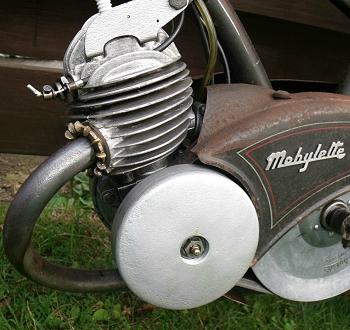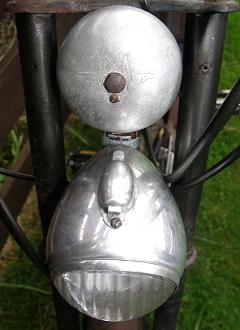
French manufacturer Motobécane/Motoconfort was established in the production of motor cycles since the early 1920s and, subsequent to World War Two, began manufacture of a super lightweight ‘Poney’ Vélomoteur of 63cc. It soon became apparent that a popular new ‘economy’ transport was developing around 50cc pedal-assisted motors so Motobécane set about the construction of a prototype in 1949 based on the assembly of existing components from other machines built onto a pre-war bicycle frame, which was strengthened for the purpose. Utilising a sleeved-down version of the ‘Poney’ motor to 50cc, the new machine was little more than a basic and simple motorised bicycle. With direct drive, its primary belt to a fixed flywheel was tensioned by adjusting the engine, then the final drive chain tightened by movement of the rear wheel.
Titled as a ‘Mobylette’, the new AV3 ‘Moped’ was first presented to an enthusiastic public at the 1949 Utrecht Autumn Fair with its French debut soon afterwards at that year’s Paris Salon. The immediate appeal was its affordable simplicity, and a product that many cyclists of the day could readily relate to as a more effective transport for their daily commute to work, while its step-through frame design appealed to both men and women.
It’s easy to make the mistake of thinking that a machine fitted with an AV3 engine automatically makes the bike an AV3, but it doesn’t quite work like that…
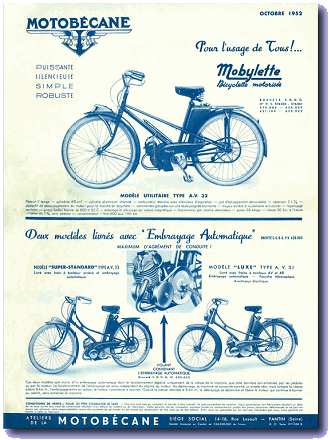
The original AV3 moped was produced from 1949–53, featured a rigid front fork and frame, with calliper brakes front and rear, and had direct drive (no clutch).
Other models fitted with the same AV3 engine appeared in 1952:
AV31 ‘Luxe’ to 1955, with telescopic forks, front and rear drum brakes, and ‘automatic’ clutch.
AV32 ‘Utilitaire’ & ‘Service’ to 1962, basic models with rigid fork, front & rear calliper brakes, and direct drive.
AV33 ‘Super-Standard’ to 1960, rigid fork, calliper front brake & drum rear, and ‘automatic’ clutch.
So the later frame types came to designate their respective models, which continued through fitment of different engine types beyond the AV3, through the AV35, and finally the AV7 motors.
With telescopic forks, front and rear drum brakes, and automatic clutch, our feature machine represents the very latest top-of-the-range AV31 ‘Luxe’ model, with its frame and original engine both dated at 1952.
Unlike the more familiar and various types of later chrome bore Motobécane engines, the AV3 motor has an aluminium cylinder with iron liner. The piston is a deflector top design arranged sideways to the engine, so that spent gasses exhaust to the left-hand side of the motor, where the cylinder fins swell asymmetrically out to disperse the uneven heat.
The piston rings are mighty circles of iron by modern standards, 39 × 3mm D-slot with angle-cut and plain-butted ends. There are no ring pegs, so the rings are free to rotate around the piston. The ends of the rings are contained from finding their way into the transfers due to the small sizes of these ports, while the exhaust ports comprise no more than a few small holes drilled through the wall of the liner. This is an arrangement that will not promote efficiency at revs, so there is never going to be an expectation of much speed from this design.

The motor is rated about 1bhp @ 3,400rpm and given a nominal speed around 28–30km/h (20mph)
This first-series AV3 engine has no crank seals, so that means that it needs to be run with a heavy mineral oil mix in the fuel. Recommended mix is 8% Castrol Z (SAE10), which is 12:1 ratio, and if you might think that’s a bit thick … Motobécane further recommended an extra glutinous 9:1 ratio for running in a new engine!
The old-pattern small 0.55 gallon fuel tank mounts in the crook of the frame between the saddle stem and rear mudguard.
There’s a whole load of stylish and elegant deco features about this top-of-the-range machine: the curvaceous frame tubes, sweeping side-panels, the facing figureheads in the pedal crank chain-wheel, and ornate aluminium lamps, which are turned off & on by a sliding bar in the headlamp … it’s all so artistic and classical, completely charming in a strange and ancient mechanical way.
The arrangement of the low headlamp on the front forks with the electric bell mounted above, appears visually unusual, and presents a different ‘face’ to the front of the machine.
Quaint inverted levers sprout from the handlebar ends but, on this occasion, we’re somewhat comforted by the knowledge that the other ends of the cables are connected to drum brakes, so we’re hopeful that we might have some moderate braking.
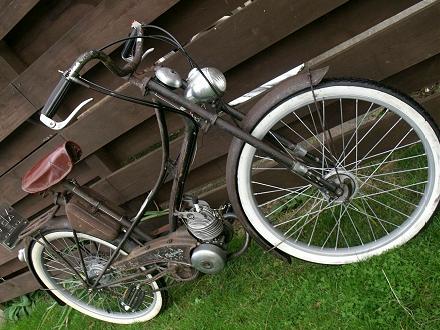
We have no option of starting our AV31 on the stand, because its first series Luxe frame has no stand! It wasn’t supplied with one, there is no stand bracket to even fit one, so you just lean it up wherever you go. Starting therefore is by pedalling it up the road, which is performed in the time honoured and prescribed manner. Unscrew the fuel valve in the top of the tank, there’s a little thumb lever off the left handlebar to pull on the choke, twist forward the throttle to decompress a horizontal valve in front of the cylinder head, then pedal away. The engine spins and fires up, but takes a couple more attempts before we manage to keep it running by feathering the choke. By the time the motor has cleared to run without the choke and you can rev it on the throttle, is about the point that you will start to appreciate that there’s something rather different going on with the clutch. This doesn’t function like the more familiar automatic ‘Dimoby’ clutches of later years; it’s a sort of semi-automatic mechanism that needs you to pedal the bike up to 2 or 3 mph for the clutch shoes to lock in, however, when they disengage again at low speed, you can rev the engine like it’s out of gear, and it doesn’t take up the drive! The clutch will only re-engage when you pedal the bike up to 2 or 3 mph again. This is what they called an automatic clutch in medieval times! And when we say ‘re-engage’, these old-style clutches kick the shoes in with a bang. There’s no soft feel or gradual take-off here, the clutch shoes come on like chucking a brick into a food blender, so they require a rather different technique to make the initial phase more civilised.
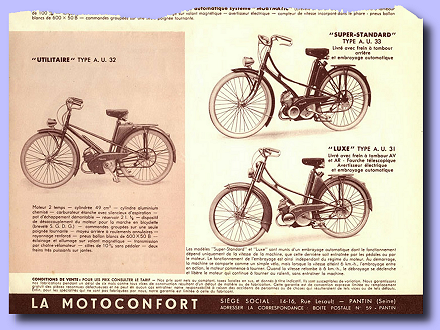
The 1954 catalogue was the first where
Mobylettes had centre stands.
If the engine is revving before the clutch engages, the shoes lock in violently to deliver a judder though the cycle frame, while the motor revs practically plummet to a stall–it’s an unpleasant effect that you need to work round. The trick is to pedal off with low revs barely above tick-over, then open the throttle after the clutch has engaged. The process is counter-intuitive to any normal automatic clutched operation, and it does take a while to master the method.
The motor delivers its feeble power in a soft and delicate manner, gently coaxing the cycle up to a best paced 21mph along the flat. The bike fades faintly against gradients, dropping down to 14mph against a mild incline, and is already subtly suggesting to the rider that it would appreciate some light pedal assistance. Against any more significant inclines the rider would certainly need to be prepared for some exercise, because hills are clearly not a strong area for the AV3 motor.
Our downhill run paces at 26mph, but there’s no way one of these machines would be likely to get to such dizzying speed without the assistance of gravity or a powerful tailwind along the flat. There was no suggestion that the motor was over-revving at this speed since the standard gearing was obviously higher than the motor could normally pull with the low power it develops.
The 6V × 6W headlamp produces a comforting yellow glow though not anything you’re likely to see much by on a dark country road, while the 6V × 6W rear lamp generates a baleful red glow like a threatening demon’s eye, to guard your back.
The ‘Timbrelec’ electric bell produces a cheerful jingling ring, which will bring a smile to any pedestrians face as their attention is raised to your presence. So much more pleasant than a horn, ding-a-ling-a-ling, what a nice and friendly old moped…
The AV31 ‘Luxe’ model was only listed from 1952–55, though later models with second and third series frames did adopt the added convenience of a centre stand before morphing into the even more pompously titled AV34 ‘Grand Luxe’ (which was basically the same equivalent specification model, with new fourth series frame having no saddle stem stays, so a larger capacity 0.8 gallon tank could now be nested over the freestanding tube).
Motor Imports Co. Ltd. of 7 Gresham Road, London SW9 were the importers of Motobécane Mobylettes to the UK, but the AV31 didn’t seem to have been a model on their list so, other than the occasional private ‘grey import’, they’re probably unlikely to be found much in this country.


